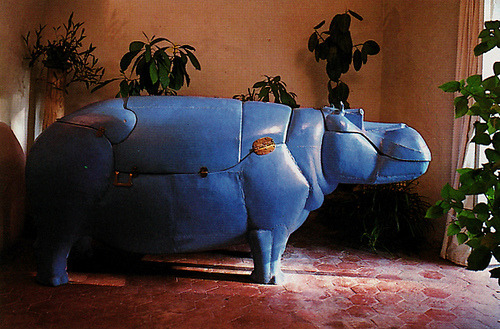

“For a long time now, the fascinating creations of Claude and Francois-Xavier Lalanne have graced private collections all over the world. The imaginative work in wood and metal by Francois-Xavier is at first a bit startling: hippopotamuses splashing around in bathrooms; frogs croaking at the edge of swimming pools; sheep grazing on floors and carpets of the most respectable drawing rooms. Recently, as a matter of fact, a flock of his sheep clambered up the escalator of the Centre Georges Pompidou, in Paris, to the alpine heights of the Musée d’Art Moderne.
However, critics have often been reluctant to take the droll Lalanne bestiary with any seriousness. The problem is obvious. In what category do these fabricated animals, disguised as chairs and writing tables and bathtubs, belong? Are they furniture, or are they sculpture? “Simply think of them as Lalannes,” say the two creators, with calm reasonableness, for they have never exactly considered themselves either artists or craftsmen. The precise definition of their work is difficult to reach. In the past, for example, their studio in Montparnassse had all the cluttered appearance of a mechanic’s workshop. There were soldering irons, bits and drills everywhere, electroplating baths - as well as an enormous and haphazard collection of objects trouvés used in their work.
Even today, their house in the country, in a village on the edge of the forest of Fontainebleau, has much the same atmosphere. It is difficult to realize that this used to be a farm supplying the nearby city of Paris with fruits and vegetables and the famous cream cheese of Fontainebleau. The Lalannes have become country people, and very honestly they have installed themselves in the manner of village blacksmiths.”

“There is little doubt that they acquired the village house in order to give their lives an orientation that is at once creative and practical. During the years they lived in Paris they did a variety of work for others, such as the décor they created for the Christian Dior boutique. At the same time, however, Francois-Xavier was beginning to learn the techniques of working with copper and brass – the metal horses he created for the ballet choreographer Maurice Béjart for the Paris Opera are an example – while Claude, in work she was doing for the house of Lanvin, was making herself a master of electroplating. Instinctively, they were becoming restless with such ephemeral work as window decoration, boutique décor and stage sets. This dissatisfaction surely led them to begin a reevaluation of the traditional rules of furniture design, and hey decided to work entirely for themselves.
Soon people of imagination became enchanted with the unique vision of the Lalannes, with the monumental insolence of such works as their rhinocrétaire, a desk in the form of a rhinoceros, used by the architect Emile Aillaud. Other commissions followed: Yves Saint-Laurent ordered a bar, for example, and designer Karl Lagerfeld a drawing table. Eventually, gallery owner Alexander Iolas began to promote their work.”


“‘Why is a raven like a writing desk?’ the Mad Hatter asked Alice. And, in the same vein of reasonable insanity, the Lalannes see no reason why a rabbit with floppy ears should not serve as a weathervane. Basically, what they are doing is giving reality to the dreams of poets - and of children. Did you never dream of a hippopotamus splashing in a stream? With unimpeachable, if slightly mad, logic, the Lalannes produced their bathtub design in the form of that frolicking animal. And what child has not pretended to smoke a banana as if it were a cigar? Naturally the Lalannes have obliged with a cigar box in the form of a banana.”



“Their heads filled with such dreamlike furniture, the Lalannes pay little attention to filling their own house with consciously decorative objects. The furniture they have was acquired at local auctions or gathered from family attics. The result is a somewhat haphazard collection of rustic pieces from the period of Louis XVI through the early 1900s, along with some venerable upholstered pieces from the Second Empire. Everywhere their approach is casual and imaginative. A sheepskin – clearly there are many on hand – is thrown carelessly over a steel armchair, for example, and a crumpled piece of paper is the shade for a kiosk ornament serving as a lamp. Everything, transformed by the infections humor of the artists, undergoes a sea change of startling dimension.
Far from being egotistical, the two artists refuse to have their work mass-produced, but their output is generous and brings pleasure to many. The work of the two Lalannes does bring joy, and this facet has recently been recognized by the city of Paris. Francois-Xavier has been asked to design a garden to occupy what used to be the great markets of Les Halles. One part of it, set aside for children, will be designed by Claude herself. The results can only be charming and unique, surely providing yet another example of the couple’s rare imagination and the appeal of their compelling creations.”


ALL IMAGES OF ATELIER LALANNE AS PHOTOGRAPHED FOR ARCHITECTURAL DIGEST, FEBRUARY, 1981; ALL PHOTOGRAPHY BY MARC LACROIX; ALL TEXT BY JEAN-LOUIS GAILLEMIN, TAKEN FROM THE SAME ISSUE
Δεν υπάρχουν σχόλια:
Δημοσίευση σχολίου